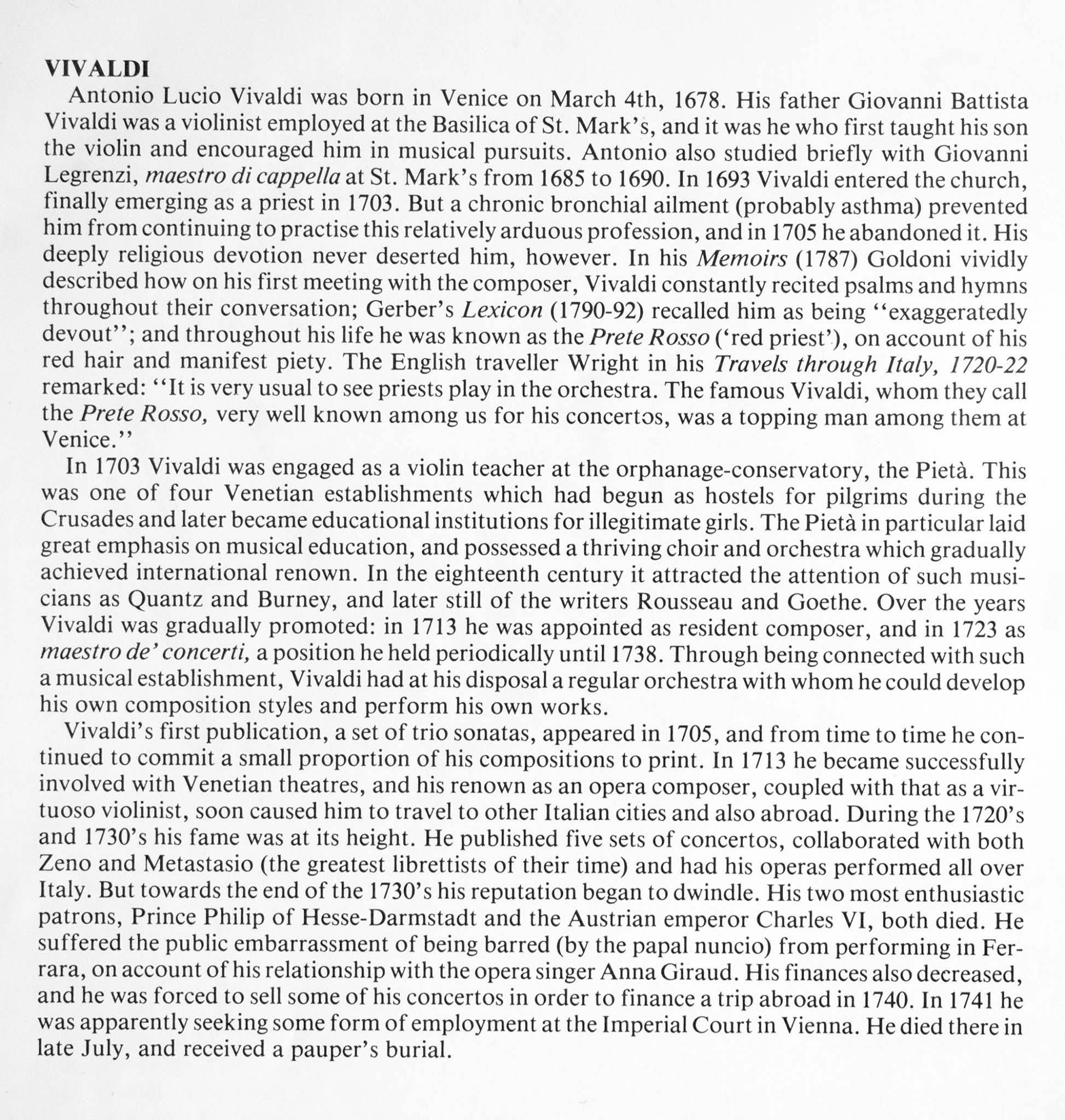

It was during his term in Mantua, from around 1717 to 1721, that he wrote his four-part masterpiece, The Four Seasons. In addition to his regular employment, Vivaldi accepted a number of short-term positions funded by patrons in Mantua and Rome. His two most successful operatic works, La constanza trionfante and Farnace, were performed in multiple revivals during Vivaldi's lifetime. In addition to his choral music and concerti, Vivaldi had begun regularly writing opera scores by 1715 about 50 of these scores remain. In 1716, he was promoted to music director. Under Vivaldi's leadership, the orchestra gained international attention. The most talented musicians joined an orchestra that played Vivaldi's compositions, including religious choral music. The Ospedale was an institution where orphans received instruction - the boys in trades and the girls in music. He composed most of his major works in this position over three decades. Musical CareerĪt the age of 25, Vivaldi was named master of violin at the Ospedale della Pietà (Devout Hospital of Mercy) in Venice. Health problems prevented him from delivering mass and drove him to abandon the priesthood shortly after his ordination. Due to his red hair, Vivaldi was known locally as "il Prete Rosso," or "the Red Priest." Vivaldi's career in the clergy was short-lived.

At the age of 15, he began studying to become a priest. Vivaldi sought religious training as well as musical instruction. While his violin practice flourished, a chronic shortness of breath barred him from mastering wind instruments. Through his father, Vivaldi met and learned from some of the finest musicians and composers in Venice at the time.

Vivaldi compositions professional#
His father, Giovanni Battista Vivaldi, was a professional violinist who taught his young son to play as well. Early LifeĪntonio Lucio Vivaldi was born on March 4, 1678, in Venice, Italy. He was also known for his operas, including Argippo and Bajazet. A prolific composer who created hundreds of works, he became renowned for his concertos in Baroque style, becoming a highly influential innovator in form and pattern. All instances of editorial intervention which go beyond simple transliteration of the old notation or which do not conform to a precise system of graphical conversion described below will be mentioned in the Critical Commentary or shown by special signs.įabrizio Ammetto, Alessandro Borin, Cesare Fertonani, Karl Heller, Antonio Moccia, Federico Maria Sardelli, Reinhard Strohm, Michael Talbot, Colin R.Antonio Vivaldi was ordained as a priest though he instead chose to follow his passion for music. A Critical Commentary, concerned with original readings and their interpretation, lists all variations existing between the main source and the collated sources. The edition aims at maximum fidelity to the composer’s intentions as ascertained from the sources in the light of the contemporary notational and performance practice. The editorial method employed for single work or groups of works is described in the Introduction. The guiding principles behind the Critical Edition are set out in detail in the New Editorial Norms prepared by the Editorial Committee of the Istituto Italiano Antonio Vivaldi. However, instrumental works preserved only in manuscript sources are published individually or in groups of similar works (linked by scoring, destination, source location etc.). The ambitious project aims to publish the scores of all the operas, and all the serenatas, the sonatas, concertos and sinfonias, sacred and secular compositions, unfinished or incomplete works and new recent discoveries, starting with the works contained in the published collections (with or without opus number) that appeared during his lifetime.Įach volume includes, in addition to the authentic works within a given published collection, the most significant variants of the manuscript tradition. From 1984 onwards The Istituto, continuing its collaboration with Ricordi, initiated the Critical Edition of Vivaldi’s works, which is still being published today. The composer and world-famous scholar of Italian music of the 17 th-18 th centuries, had already revised Claudio Monteverdi’s Opera Omnia. Between 19 the Istituto Italiano Antonio Vivaldi, in collaboration with Casa Ricordi, supervised the publication of 529 instrumental works and 13 sacred vocal works by Vivaldi, appointing Gian Francesco Malipiero as Artistic Director.


 0 kommentar(er)
0 kommentar(er)
